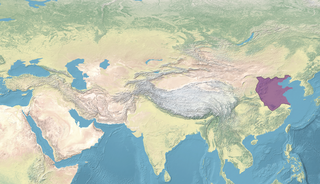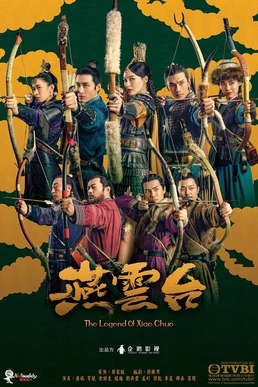
The Northern and Southern dynasties was a period of political division in the history of China that lasted from 420 to 589,following the tumultuous era of the Sixteen Kingdoms and the Eastern Jin dynasty. It is sometimes considered as the latter part of a longer period known as the Six Dynasties (220–589). The period featured civil war and political chaos,but was also a time of flourishing arts and culture,advancement in technology,and the spread of Mahayana Buddhism and Taoism. The period saw large-scale migration of Han people to lands south of the Yangtze. The period came to an end with the unification of China proper by Emperor Wen of the Sui dynasty.

Prefectures are one of four types of prefecture-level divisions in China,the second-level administrative division in the country. While at one time prefectures were the most common prefecture-level division,they are in the process of being abolished and only seven formally-designated prefectures remain.
Ji Kang,sometimes referred to as Xi Kang,courtesy name Shuye,was a Chinese composer,essayist,philosopher,and poet of the Three Kingdoms period. He was one of the Seven Sages of the Bamboo Grove who held aloof from the dangerous politics of third-century China to devote themselves to art and refinement.

The Yuwen is a Chinese compound surname originated from a pre-state clan of Xianbei ethnicity of Xiongnu origin during the era of Sixteen Kingdoms in China,until its destruction by Former Yan's prince Murong Huang in 345. Among the eastern Xianbei clans that ranged from the central part of the present day Liaoning province and eastward,Yuwen clan was the largest,and was awarded the position of the leader of eastern Xianbei (東部大人) by Chinese rulers. A descendant of the Yuwen tribe,Yuwen Tai,established the Northern Zhou Dynasty in the 6th century.
Yuanhe Xingzuan "The register of the great families from the Yuanhe reign (806-820)" vol. 6,the Yuwen part 2 records:
(宇文)本遼東南單于之後,有普回因獵得玉璽,以為天授. 鮮卑俗呼天子為宇文,因號宇文氏.
(The Yuwen) originally were the descendants of the southern Shanyu. Someone within them called Puhui got a jade seal when he was hunting. This was regarded as a sign of imperial enthronement from heaven. According to Xianbei tradition,the son of the heaven was called the Yuwen. Thus (Puhui) called himself the Yuwen.

Qi,known as the Northern Qi,Later Qi (後齊) or Gao Qi (高齊) in historiography,was a Chinese imperial dynasty and one of the Northern dynasties during the Northern and Southern dynasties era. It ruled the eastern part of northern China from 550 to 577. The dynasty was founded by Gao Yang,and was eventually conquered by the Xianbei-led Northern Zhou dynasty in 577.

The ruan is a traditional Chinese plucked string instrument. It is a lute with a fretted neck,a circular body,and four strings. Its four strings were formerly made of silk but since the 20th century they have been made of steel. The modern ruan has 24 frets with 12 semitones on each string,which has greatly expanded its range from a previous 13 frets. The frets are commonly made of ivory or in recent times of metal mounted on wood. The metal frets produce a brighter tone as compared to the ivory frets. It is sometimes called ruanqin,particularly in Taiwan.

The Seven Sages of the Bamboo Grove were a group of Chinese scholars,writers,and musicians of the third century CE. Although the various individuals all existed,their interconnection is not entirely certain. Several of the seven were linked with the Qingtan school of Daoism as it existed in the state of Cao Wei.

Mi Fu was a Chinese painter,poet and calligrapher who was born in Taiyuan during the Song dynasty. He became known for his style of painting misty landscapes. This style would be deemed the "Mi Fu" style and involved the use of large wet dots of ink applied with a flat brush. His poetry was influenced by Li Bai and his calligraphy by Wang Xizhi.

Zhou,known in historiography as the Northern Zhou,was a Xianbei-led dynasty of China that lasted from 557 to 581. One of the Northern dynasties of China's Northern and Southern dynasties period,it succeeded the Western Wei dynasty and was eventually overthrown by the Sui dynasty.
Yan Rou was a military general of the state of Cao Wei during the Three Kingdoms period of China. He previously served under the warlord Cao Cao in the late Eastern Han dynasty.

Ruan Ji (210–263),courtesy name Sizong,was a Chinese musician,poet,and military offier who lived in the late Eastern Han dynasty and Three Kingdoms period. He was one of the Seven Sages of the Bamboo Grove. The guqin melody Jiukuang is believed to have been composed by him. At one time an infantry colonel,he was also known as Ruan Bubing.

Ruan is a Chinese surname.

Lantian County is a county under the administration of Xi'an,the capital of Shaanxi province,China. It is the easternmost and second-most spacious of the 13 county-level divisions of Xi'an. The county borders the prefecture-level cities of Weinan to the northeast and Shangluo to the southeast,Lintong District to the north,Chang'an District to the west,and Baqiao District to the northwest.
Seven scholars of Jian'an or Chien-an,also translated as the "seven philosophers or masters of Jian'an",were a group of seven Chinese intellectuals of the Eastern Han dynasty. The name was coined by Cao Pi. The Jian'an era was the era from 196–220 during the reign of Emperor Xian. Known as the time of unrest preceding the Three Kingdoms era,the period gained popularity in the East Asian culture.

Jian'an poetry or Chien-an poetry,refers to the styles of Chinese poetry particularly associated with the end of the Han dynasty and the beginning of the Six Dynasties era of China. This poetry category is particularly important because,in the case of the Jian'an poetic developments,there is a special difficulty in matching the chronology of changes in poetry with the usual Chinese dynastic chronology based on the political leadership of the times. For example,according to Burton Watson,the first major poet of the new shi style that emerged at this time was Cao Zhi,one of the sons of Cao Cao,a family which came into power at the end of Han and developed further during the Three Kingdoms era of the Six Dynasties period.
Six Dynasties poetry refers to those types or styles of poetry particularly associated with the Six Dynasties era of China. This poetry reflects one of the poetry world's more important flowerings,as well as being a unique period in Classical Chinese poetry,which,over this time period,developed a poetry with special emphasis on romantic love,gender roles,and human relationships. The Six Dynasties era is sometimes known as the "Age of Fragmentation",because China as a whole through this period lacked unification as a state,at least for any extended period of time;and,instead,many states rose and fell,often overlapping in existence with other states. Which of the various states and dynasties constituted the "6" dynasties of the Six Dynasties period varies somewhat according to which of the traditional selection criteria are chosen. The Six Dynasties era covers several somewhat overlapping main periods including all of the following:the Three Kingdoms (220–280),Jin dynasty,the Sixteen Kingdoms,and the Southern and Northern Dynasties (420–589). Sometimes,chronological discrepancies occur in regard to the turbulent political events of the time,from which these traditional historical-era designations derive,together with the somewhat different chronology of poetic developments. Thus,neither the lives of the poets nor the trends in their poetry fit gently and neatly together with these period dates. Furthermore,conversions to the Common Era dating system can create further complications. However,regardless of the chronological difficulties,major developments of poetry during the Six Dynasties include formalizing the distinction between the Jian'an era regular yuefu and the shi style poetry,further development of the fu,theoretical work on technique,and the preservation of both Six Dynasties and earlier poetry by collecting and publishing many of the pieces which survive today into various anthologies consisting all or in part of poetry.

The Legend of Xiao Chuo is a 2020 Chinese television series based on the novel Yan Yun Tai by Jiang Shengnan. It stars Tiffany Tang in the title role,along with Shawn Dou,Charmaine Sheh and Jing Chao. The series chronicles the life of legendary Empress Xiao Yanyan.

Li Xian was a Northern Zhou general and Governor of Dunhuang. He was born in 502 CE in Guyuan,at the time under Northern Wei rule. As a soldier,he served the three dynasties of the Northern Wei,Western Wei,and Northern Zhou. Emperor Yuwen Tai entrusted him with the education of two of his sons during 6 years,as the imperial court had become too dangerous,and one of them,Yuwen Yong,would become Emperor Wu of Northern Zhou. Li Xian was in charge of defenses on the northern frontier of the Chinese Empire,in contact with the Silk Road. He died in Changan at the age of 66,in 569 CE. He was important enough to be mentioned in the Zhoushu and the Beishi. He was the great-grandfather of the famous Sui dynasty princess Li Jingxun.
Li Yong,courtesy name Taihe,also known as Li Beihai,was a Chinese politician,writer,and calligrapher active during the Tang dynasty.














